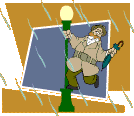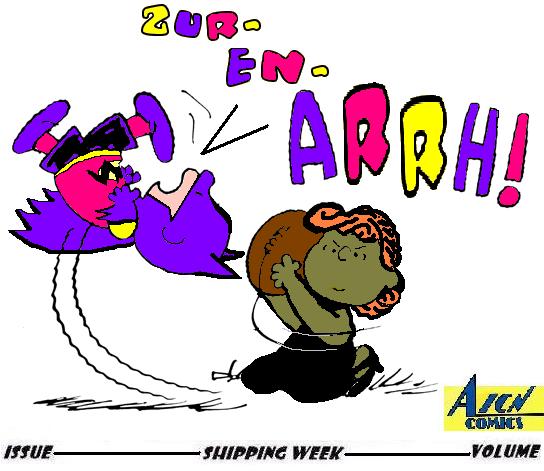
| #29 | 11/26/08 | #7 |
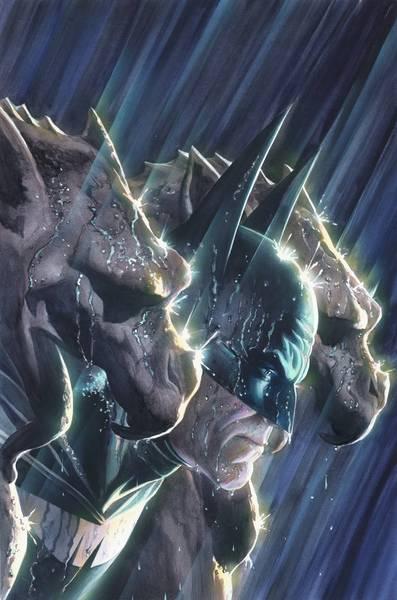
An @$$Hole 2 in 1 Review BATMAN #681
Writer: Grant Morrison Art: Tony Daniel (pencils), Sandu Florea (inks) Publisher: DC Comics Reviewers In Plural: Stones Throw & Ambush Bug
STONES THROW (STONE): It’s over! And a helicopter exploding with Batman on it is the big conclusion?AMBUSH BUG (BUG): Yeah, we waited all this time for this?!? I've been trying to keep mum about this book and do what a lot of people suggest and wait till the end to judge, because Morrison is a writer whose work is best read as a whole. Well, I read the whole thing and I have to say that I'm disappointed.
STONE: I think DC has to bear some of the blame for trying to turn the story into some kind of reprisal of the DEATH OF SUPERMAN, which it patently wasn’t. It’s not even clear if Batman is dead by the end. I can only imagine what the poor schmuck who read one of the mainstream media articles about the storyline and decided to take a look thought.
BUG: But there were a lot of things to like about this book, especially this issue in particular, that were enjoyable to read despite the shitty "death scene". Every scene with the Joker in this one was pretty damn perfect. I loved the way Morrison reversed the role of the Joker and almost made him an ally in this one. OK, maybe ally is too strong a word. The Joker was more like a cheerleader, rooting for Batman in order to make the Black Glove crazy and scared.
STONE: There were parts I enjoyed throughout. The KILL BILL VOL 2-style poisoned chai scene in this issue, for example. I find that the more I read outside of the books themselves (like this cool web page about the stories that inspired Morrison), the more I’m intrigued by his ideas. But, honestly, the comics themselves did not read well.
BUG: The thing that bothers me is that the Batman Family just accepts this fate. They've seen a million villains seemingly perish in the same way. Why would they immediately assume he's dead this time? Does Morrison really think that they (and us as the audience) are so stupid?
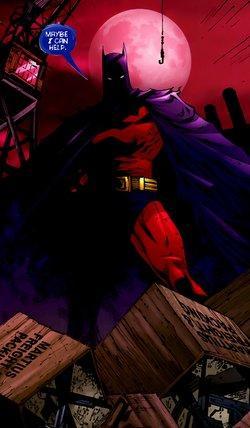 STONE: Yeah, that shot of Nightwing holding the cape and cowl made me laugh because it seemed like it belonged in a different comic altogether. Not exactly a noble reaction to seeing your adoptive father and mentor figure get blown up. It seems like Morrison had his story, which got hijacked by DC simply by way of its title. Now we’re getting a Judd Winick-written “Battle for the Cowl” coming up and who knows if Morrison will return.
STONE: Yeah, that shot of Nightwing holding the cape and cowl made me laugh because it seemed like it belonged in a different comic altogether. Not exactly a noble reaction to seeing your adoptive father and mentor figure get blown up. It seems like Morrison had his story, which got hijacked by DC simply by way of its title. Now we’re getting a Judd Winick-written “Battle for the Cowl” coming up and who knows if Morrison will return.I think the other element in this is the art. I look at what Morrison’s doing on ALL STAR SUPERMAN and FINAL CRISIS, which whatever you think of it at least has a fairly strong and simple through line of a story, and then the last few months of BATMAN, which have often been a struggle to comprehend. Tony Daniel hasn’t helped this book. Take Morrison writing in such an eccentric style and add that sketchy, early Image style of drawing and it’s kind of like trying to translate the Dead Sea Scrolls when the guy who wrote them in the first place had poor handwriting.
BUG: Tony Daniel isn't awful. He is just ill-fitting to this story. And you're right, in the hands of an artist that is able to handle the subtle yet often obtuse writing style of Morrison, this would be a far superior read. I mean, this is supposed to be a pretty important story. What was DC thinking assigning Daniel's early BRIGADE style art to this book? When you think of big Batman stories, there have always been very talented artists accompanying them. Brian Bolland, Tim Sale, Jim Lee, Frank Miller, David Mazzucchelli, even Norm Breyfogle, Neal Adams, Jim Aparo...all of these guys have contributed to huge Batman stories--stories that wouldn't be the same without their stellar pencils. Daniel is just out of his league here. I'm sure the guy has a big future in comics, but when there are multiple instances where I feel as if a panel (if not a whole page) got lost on the way to the printer, there's a problem.
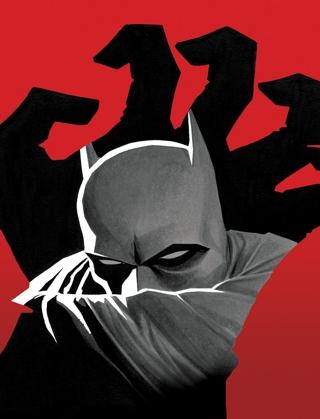 STONE: I’d have liked to see what Andy Kubert or JH Williams III would have made of it. Tony Daniel isn’t terrible, but with one of those guys the art would have had its own appeal, whereas I don’t think Daniel helped the book too much. But for all RIP was sold as an “important” story, in the end it turned out to be a fairly routine Batman tale. A sinister group tries to destroy Bruce and find out he’s really pretty tough. The one thing Morrison added is working in the 1950s and ’60s continuity. And a lot of annoying dialogue where it seems like every other line had to spell out what’s going on because nothing else did a good enough job. Maybe with the DARK KNIGHT being about the biggest thing until MAMMA MIA! some more “traditional” Joker or Two-Face stories would have been better.
STONE: I’d have liked to see what Andy Kubert or JH Williams III would have made of it. Tony Daniel isn’t terrible, but with one of those guys the art would have had its own appeal, whereas I don’t think Daniel helped the book too much. But for all RIP was sold as an “important” story, in the end it turned out to be a fairly routine Batman tale. A sinister group tries to destroy Bruce and find out he’s really pretty tough. The one thing Morrison added is working in the 1950s and ’60s continuity. And a lot of annoying dialogue where it seems like every other line had to spell out what’s going on because nothing else did a good enough job. Maybe with the DARK KNIGHT being about the biggest thing until MAMMA MIA! some more “traditional” Joker or Two-Face stories would have been better.BUG: Morrison is always experimenting with new ways to convey a story. Some are decent. Some, not so much. I can admire the guy for bringing back kooky concepts like the Rainbow Batman personality and things like that, but once again I think Morrison is guilty of having a ton of ideas and not much of a care for how to put those ideas together to make an interesting story. It's like he went down a checklist of stuff he'd like to see without really giving much thought as to how to make it work. Man-Bat ninjas? Check. Rainbow Batman? Check. Hunchback? Check. Black Glove? Check. Joker rambling discourse? Check. Oh yeah, I forgot, I promised some kind of death scene. Let me toss something in there. How about a 'splosion? The fanboys love those.
STONE: OK, count me as a Man-Bat ninja fan. That issue where they attacked the pop art gallery shows what an artist like Kubert brought to the title. The Zur-En-Arrh reveal I felt didn’t work since it was Morrison who reintroduced the phrase in the first place. So that last scene where he reveals the hidden meaning fell flat because he could have fit a meaning to any nonsense phrase with the same impact. Same kind of thing with Jezebel Jet, who was a very flat character from the beginning. Morrison having Bruce address that problem by saying he knew she was a villain all along doesn’t really solve it because he expected us readers to sit through the mystery.
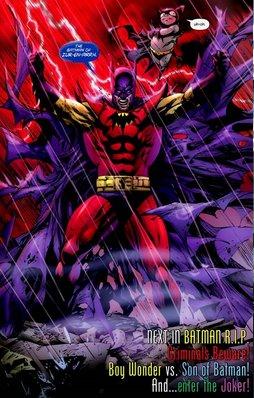 BUG: The issue skids to a halt numerous times for Morrison to explain stuff he's been doing for the last five or so issues. We get a Zur-En-Arrh explanation, an unneeded explanation of how Batman gets out of a coffin, then the worst of the worst of clichés when the Black Glove tries to earn geek cred by proving he's a big fan of EMPIRE STRIKES BACK. If a page of exposition is necessary for the reader to understand what's going on, then the comic book writer is not doing his job.
BUG: The issue skids to a halt numerous times for Morrison to explain stuff he's been doing for the last five or so issues. We get a Zur-En-Arrh explanation, an unneeded explanation of how Batman gets out of a coffin, then the worst of the worst of clichés when the Black Glove tries to earn geek cred by proving he's a big fan of EMPIRE STRIKES BACK. If a page of exposition is necessary for the reader to understand what's going on, then the comic book writer is not doing his job.STONE: You know one thing that might have made the series a fuller read? A collection of “The Stories Behind R.I.P.”. Or at least some old-school caption boxes referencing the issues where Morrison got stuff like the Batman of Zur-En-Arrh and the three replacement Batmen from. The way the story was written really took it for granted that the readers would have the same reference points as Morrison, but when few people are familiar with those old stories it’s not surprising so many were baffled.
BUG: For someone who is known as one of modern comics’ greats, there is an awful lot of amateur obviousness going on in Morrison's writing. It seems as if every writer today is tying to create a writing style that is as unique as the colorful characters they are writing. Like I said earlier, Morrison's strength and weakness is his obtuse writing style. It was obvious that Jezebel was going to be the bad guy. Making the Black Glove Bruce's father is about as hacky as you can get. Having a death scene that was so uninspired and clichéd...I was waiting for Morrison to wow me with these old comic book stand-bys, and instead he wrote straight from an Amateur Comics 101 textbook. Compared to past works, Grant was slumming it here. It’s like a modern magician doing a rabbit out of the hat trick. You’re expecting some new twist on a tired old illusion, then the magician just pulls the rabbit out of the hat and you’re like “uhm…yay?”
STONE: Anyway, who do you want to see take over as Batman?
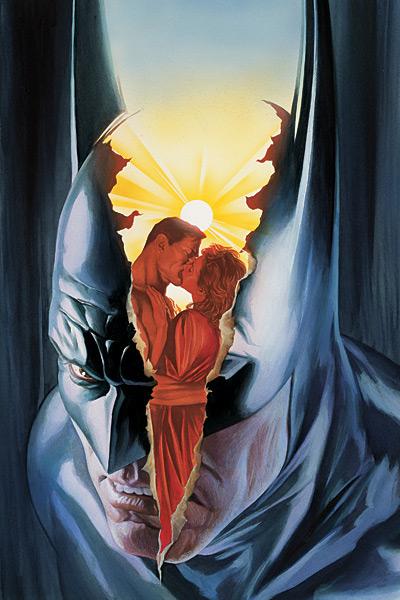 BUG:I know the obvious choice is Dick Grayson. Hell, it practically says it in that pin-up shot you mentioned earlier, but I think I would be more interested if Jason Todd became Batman. Batman's always had issues. Dick has always been pretty steady and level headed. I think that's why he and his comic are so boring. An even-keel Batman is pretty bland. I like the idea of Tim Drake becoming Nightwing. And Jason and Damien would be a pretty interesting mix for Batman and Robin. I guess that leaves Dick to either be Red Robin or the group's gay butler. Which ain't gonna happen. Dick deserves it, but that story's already been told and makes all of those stories distinguishing Dick as his own man pretty futile.
BUG:I know the obvious choice is Dick Grayson. Hell, it practically says it in that pin-up shot you mentioned earlier, but I think I would be more interested if Jason Todd became Batman. Batman's always had issues. Dick has always been pretty steady and level headed. I think that's why he and his comic are so boring. An even-keel Batman is pretty bland. I like the idea of Tim Drake becoming Nightwing. And Jason and Damien would be a pretty interesting mix for Batman and Robin. I guess that leaves Dick to either be Red Robin or the group's gay butler. Which ain't gonna happen. Dick deserves it, but that story's already been told and makes all of those stories distinguishing Dick as his own man pretty futile.You?
STONE: I’m looking forward to Neil Gaiman’s two issues coming up, but I’m not sure how well anything is going to follow, seeing as how it seems most DC writers don’t have much of a clue what Morrison was getting at (including Dan DiDio, who kept saying “RIP could stand for a lot of things” in his promotion). I guess a more street-based, dirty-fighting Batman would be an interesting take if Jason Todd is the way they’re going to go. But this comic didn’t really leave me feeling it was time to move on from Bruce Wayne. A helicopter explosion and a “six months later” bit doesn’t really cut it as a conclusion, and it’s looking pretty shaky if Morrison will ever wrap up what he wanted to do. The one thing I think may be “Resting In Peace” for a while is the ultimate hard@$$ take on Batman that Morrison helped popularise in JLA, since he takes it to such a ridiculous extreme here. Constructing a backup personality isn’t something you can top easily.
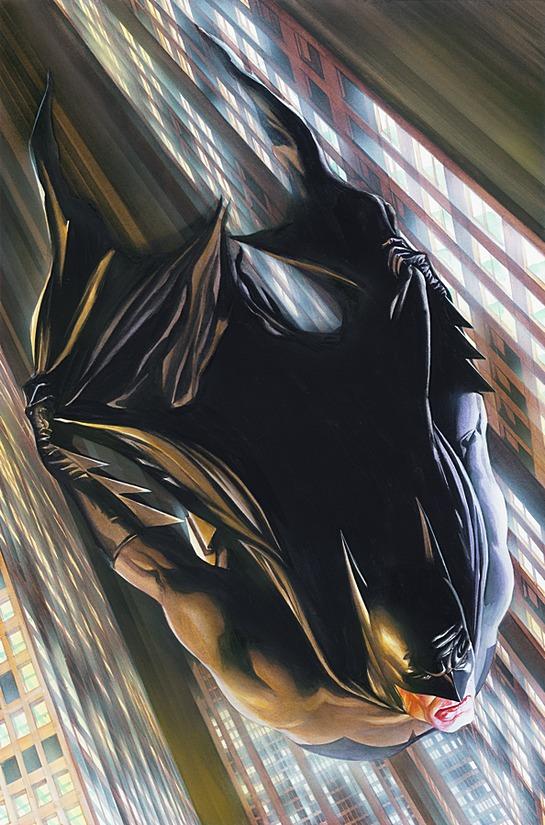 BUG: Yeah, resting the DCU on Morrison's unstable shoulders was a huge blunder on DC's part. You don't let a wildcard like the Joker run the Secret Society of Super-Villains. You let him do what he does best and leave the leadership to the methodical thinking of Lex Luthor (AKA Geoff Johns). To hear that now, after sitting through R.I.P., we are being asked to wait and see the REAL final fate of Batman in an upcoming issue of FINAL CRISIS is enough to make me give up caring for good and cements it that Morrison really doesn't have a plan here as the apologetic fans would like to think. R.I.P. wasn't really a story at all, just a mystery grab bag of cool and stale ideas. Didio even toyed with the title, saying that it may not even mean Rest In Peace. So what the hell did it mean anyway?
BUG: Yeah, resting the DCU on Morrison's unstable shoulders was a huge blunder on DC's part. You don't let a wildcard like the Joker run the Secret Society of Super-Villains. You let him do what he does best and leave the leadership to the methodical thinking of Lex Luthor (AKA Geoff Johns). To hear that now, after sitting through R.I.P., we are being asked to wait and see the REAL final fate of Batman in an upcoming issue of FINAL CRISIS is enough to make me give up caring for good and cements it that Morrison really doesn't have a plan here as the apologetic fans would like to think. R.I.P. wasn't really a story at all, just a mystery grab bag of cool and stale ideas. Didio even toyed with the title, saying that it may not even mean Rest In Peace. So what the hell did it mean anyway?STONE: Umm…Re-reading Is Prerequisite?
Best I got.
BUG: So before we go, we haven't mentioned the Darth Vader thing. What do you think of the big reveal that Thomas Wayne is the big bad?
STONE: I’m not sure if it’s that simple. Apparently this all links in with Morrison’s earlier GOTHIC miniseries and that could actually be the Devil there (on a break from ruining Spider-Man’s marriage) trying to break Batman. Either way, I can’t see any changes to Thomas Wayne sticking. Stuff’s been done with the Waynes before but the purity of Batman’s origin always wins out. I have to say, it barely even struck me as a big reveal. I did recognize the bat-mask and suit as Thomas Wayne’s from a classic story I have seen but I think that’s more symptomatic of Morrison’s “throwing-shit-at-the-wall” approach on this book. I read that he changes his writing style depending on what he’s writing, and so BATMAN is written quickly and on the spur of the moment, while ALL STAR SUPERMAN is more measured, and I think it shows. Despite some cool ideas, this was pretty all over the place, and I guess I’m feeling pretty apathetic as to where it goes from here.
BUG: I agree. As much as Stan Lee tried to make stories that mattered with Spidey all those years ago, these days, there are so many writers trying to make their definitive, status quo shaking stamp on an icon that nothing sticks. Which kind of sucks. I wish writers would go back to writing strong stories instead of trying to make THE END ALL BE ALL BATMAN STORY THAT ROCKS YOUR SOCKS OFF AND PUT THEM BACK ON JUST TO ROCK THEM OFF AGAIN…FOR THE FINAL TIME, THIS TIME, I PROMISE. Take the Man-Bats vs Batman in the museum story, probably one of Morrison's strongest Batman single issue stories to date. It was just a fun story. And it will be remembered as one of the coolest ones. Morrison didn't have to revamp Martha Wayne as a chain smoking transvestite monkey-rapist or turn Alfred into a Swahili speaking octopus to make a good story. He just went with a single idea and wrote an exciting story around it. I wish more comics were like that one.
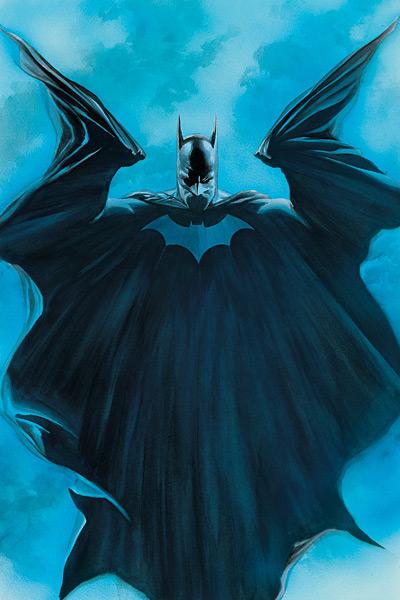 If the Black Glove is Thomas Wayne (and Morrison left it ambiguous as hell), then it leaves a bad taste in my mouth. I mean, sure it opens up story potential, but if it's stories written by Bruce Jones or Judd Winick, I think the guy was better left dead. Morrison doesn't seem to have the attention span to stick through with one story. All he does is toss some imaginative balls in the air and leave them for lesser writers to juggle.
If the Black Glove is Thomas Wayne (and Morrison left it ambiguous as hell), then it leaves a bad taste in my mouth. I mean, sure it opens up story potential, but if it's stories written by Bruce Jones or Judd Winick, I think the guy was better left dead. Morrison doesn't seem to have the attention span to stick through with one story. All he does is toss some imaginative balls in the air and leave them for lesser writers to juggle.Final thoughts on this book?
STONE: Final thoughts? Well, as much as Morrison had his usual imaginative balls (heh heh), I guess I have to ask myself the same question I did after finishing each installment. Ultimately, I don’t think it was a successful Batman story, and I don’t think it’s one I’d read again. I mean, I’m already struggling to think of a memorable cliff-hanger from any of the issues. It was just kind of a morass of scratchy art and non sequitur dialogue. It’s almost like it was a different writer from ALL STAR SUPES or FINAL CRISIS. Maybe Morrison had to have someplace to indulge his most madcap excesses.
BUG: Like any writer, Morrison is bound to pass some winners and some stinkers. Although I think it was admirable to homage some of the kookier stories of Batman past, I think if you’re going to do that, you have to ground it in some kind of reality. Under a better artist, during a time when there wasn’t so much instability in the DCU editorially, and if Morrison had kept a better schedule, this may have been an interesting experiment. But since we’re getting a healthy portion of the Grant who forgets how to end a story with the oft delayed FINAL CRISIS, 3D SUPERMAN (remember that?), and this story, I need a break from Morrison. He’s a bold idea man who needs someone to reel him in. This story is evidence of that. Although the final issue of RIP had moments of cool and fun, Morrison’s ideas crushed the feeble story structure he built around it.
STONE: Well, I guess that about wraps it up. But do we need a cool conclusion?
BUG: Why give this review a cool conclusion? The book didn't have one!
ZING!
Aaaaand we're done here.
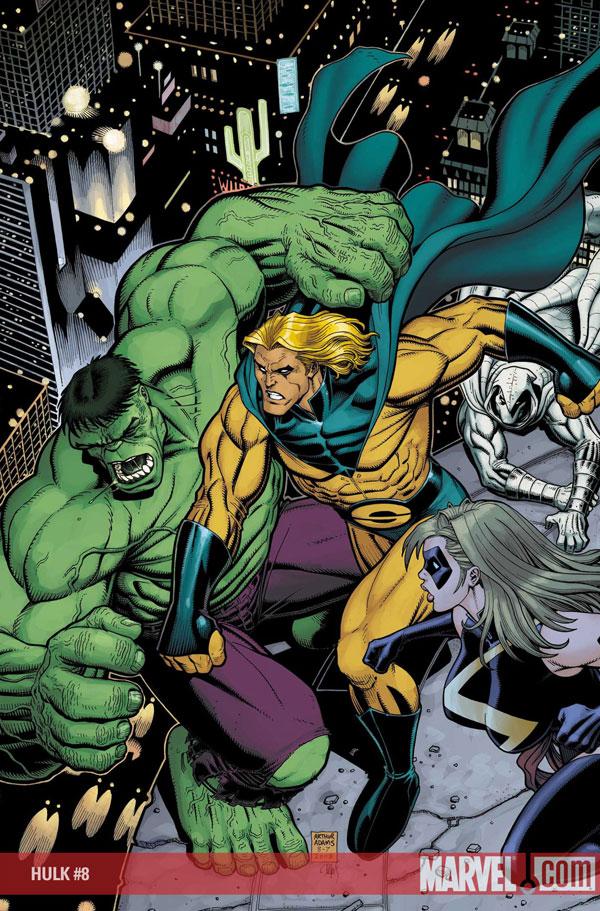
HULK #8
Writer: Jeph Loeb Artists: Arthur Adams, Frank Cho Inkers: Walden Wong, Frank Cho Publisher: Marvel Comics Reviewer: Rock-Me Amodeo
The thing that occurred to me while reading this is: if I really wanted to buy a comic with great art and crappy writing, I would go collect all the back issues of ASBAR that I previously avoided. As it is, I’m stuck with two parts of two stories whose total value is much less than the sum of its parts.The first story gives us a little bit of the Hulk, and adds a few heroes into the mix. Moon Knight and Sentry are there, and neither one seems crazy, which I actually appreciate. Joe Fixit is there…and then, inexplicably, he’s not. Why is that? Does it matter? I wish it did. And Ms. Marvel is there, too, which is always nice, but all these folks feel like the way Frank Tieri writes sometimes, like in GOTHAM UNDERGROUND: just a bunch of characters that the writer wants to play with, for no real reason other than the writer wants to play with them. I could be wrong, but they seem completely arbitrary.
I mean, if the end of this storyline requires a solution where we need a crescent shaped piece of metal, Ms. Marvel’s energy absorption powers, a dash of Sentry-vision (or whatever unique value Sentry brings to the table, I have yet to see any…ever…) and a situation where Hulk must allow Fixit to resurface…well, then, I’ll sit down to a bucket of crow. Because a solution like that actually requires these specific characters, and I’ll buy that. But if Loeb thinks he can make this a Marvel Powers Ratatouille (you know, a dash of this that and the other somehow magically comes together instead of tasting like a bunch of random crap), then I’m here to say, the main course better be worth the appetizers.
As far as the Rulk feature goes, it’s more of Frank Cho drawing bosomy, muscular women. Oh, and Rulk beats them all up. That about summarizes it, I think. Why are they fighting? Does it matter? I wish it did.
And earnestly, I ALMOST get to a part in each story where I would like to see what happens next…but then it’s over. These short snippets of story would be great if this book were, say, a weekly like TRINITY (because we can clearly see how well the concept works there, nyuck, nyuck) but it’s not even that good.
Please, Mr. Loeb, two Hulks is fine with me. But can we have ONE story…one that seems to be planned out? Actually, I’m pretty sure that both of these stories will end up in the same place as they conclude (and that would be cool and clever.) But in the meantime, the journey must be as satisfying as the payoff.

NORTHLANDERS #12
Writer: Brian Wood Artist: Ryan Kelly Publisher: DC Vertigo Guest @$$Hole Reviewer: steverodgers
NORTHLANDERS #12 continues Brian Wood’s mud-level historical tour of all things Vikings. I read the first trade (only 10 bucks!), but decided to forgo the series; Vikings aren’t my thing. However, with this new arc, he has reunited with Ryan Kelly (his artist on LOCAL) so I had to give it another shot, if only to see how Kelly could go from drawing a sweet, 12-issue emo-tour of modern America to pillaging blood-thirsty Vikings running amok in 1000 A.D Ireland.As much as I like the art and the story of NORTHLANDERS, I have to admit I was on Wikipedia for a good ½ hour like a college student just so I could figure out who the principals were, and I was still confused. The Viking conquest, and eventual assimilation into Irish culture, never came up in any of my history classes. That said, although I am missing the larger historical context of the book, I am happy to see Ryan Kelly’s depiction of Vikings getting punched, ran through with arrows, and sliced through the mouth with swords – it’s a lovingly illustrated bloodbath. In LOCAL, Kelly showed a capacity to depict some gore and creepiness, but in NORTHLANDERS he is really able to let fly and each violent encounter has an up-close, visceral punch.
Kelly’s characters all have a lived-in, un-showered ugly look to them, like the lumpy folks you might see drinking a 72-ounce coke at Six-Flags. I also can’t tell if it’s by design or if the colorist just thought the Irish and the Vikings must have looked like resplendent honkies back in those days, but everyone is colored white like resume paper and it sometimes makes it seem like you are reading a story about zombies, or maybe a community of albino Vikings.
Each arc of NORTHLANDERS centers on different characters and portions of Viking history. NORTHLANDERS #12 is essentially a Viking police procedural set in the days leading up to the Battle of Clontarf, on Good Friday in Ireland. We follow a Viking Detective Goren-type named Ragnar, who has been sent to track down an Irish insurgent, Magnus, and his daughter who are carrying out lethal attacks on the occupying forces all over the province. He is being considered a serial killer by the authorities, but we get to know him as a loving father who is fighting for his freedom. I’m assuming that we are rooting for Magnus and his daughter to escape capture, but it’s hard not to like the brutal and efficient Ragnar as he puzzles out crime scenes and pursues Magnus throughout the countryside.
Wood has ratcheted up the tension by the end of this issue. Mercenary Vikings are storming the beaches, armies are marching toward Clontarf and Magnus and his daughter are only a few steps ahead of Ragnar and his men. Although I am ignorant of much of the history, I am hooked all the same. If you like Vikings or detective stories, or just well-drawn scenes of blood and mayhem, you really can’t go wrong with NORTHLANDERS.
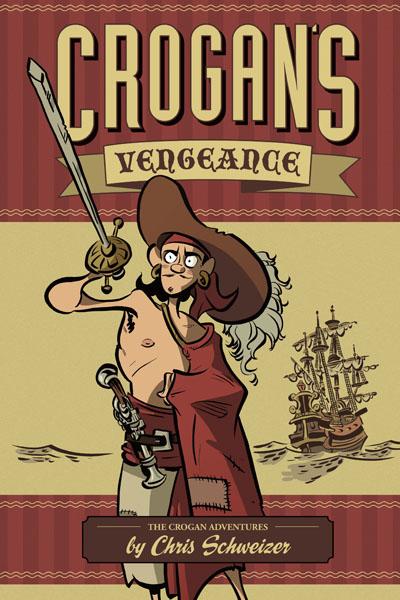
CROGAN’S VENGEANCE HC OGN
Chris Schweizer: Creator Oni Press: Publisher Vroom Socko:Old Sea Dog
If there’s been a better recent concept for a comic book series than this one, I haven’t seen it. Just looking inside the front cover put a smile on my face, and as I moved on to the actual story, that smile just kept getting wider and wider. What’s the wild, wondrous concept? It’s simply a father telling his young son about his family history. That history is laid out in the broadest of strokes on the aforementioned inside front cover with a family tree. That tree lists gunfighters, World War I pilots, brothers on opposite sides of the Revolutionary War, a private eye, an illusionist, a goddamn NINJA… Throw in a hardcover book design that evokes nothing less than the original Hardy Boys books and you have the recipe for one hell of a “Boys Own” adventure series.As for the adventure to be had in this introductory volume, when in doubt, go with pirates.
The branch of the family tree examined here is “Catfoot” Crogan, an honest seaman who has a natural aptitude for a sailor’s life as well as a keen mind for strategy. When the ship he’s serving aboard is taken by pirates, he is absorbed into their crew and quickly earns the ire of First Mate D’or. Naturally, the two come to blows, with ever escalating stakes.
If all there was to this book was a rousing story, it’d be worth a read. What makes it a great read is creator Chris Schweizer’s fun as anything artwork. His cartoonish style has a great narrative flow, and his action is both clear and detailed. More than one page, hell, more than one panel had me drawn into the story better than most entire issues from other recent stories. There’s a panel of the ubiquitous stairway duel that was one of the best images I’ve seen in an age. It’s like reading Craig Thompson by way of Hergé.
What really impresses me, however, is the ambition inherent in the genealogy angle to this series. The promise of at least another dozen plus tales of the Crogan family is incredibly ambitious, and I hope like mad that this book sells enough for us to be able to see that ambition translated into reality, if only because I want to see Schweizer’s take on the Rough Riders. Should that not come to pass, at least we still have one hell of a great pirate story on our hands.
Click here to read a free sample at Onipress.com
Aaron “Vroom Socko” Button is alleged to be the descendant of pirates, but with his twisted family tree he can’t say for sure. He does have a fondness for Barbancourt rum, but then who wouldn’t?
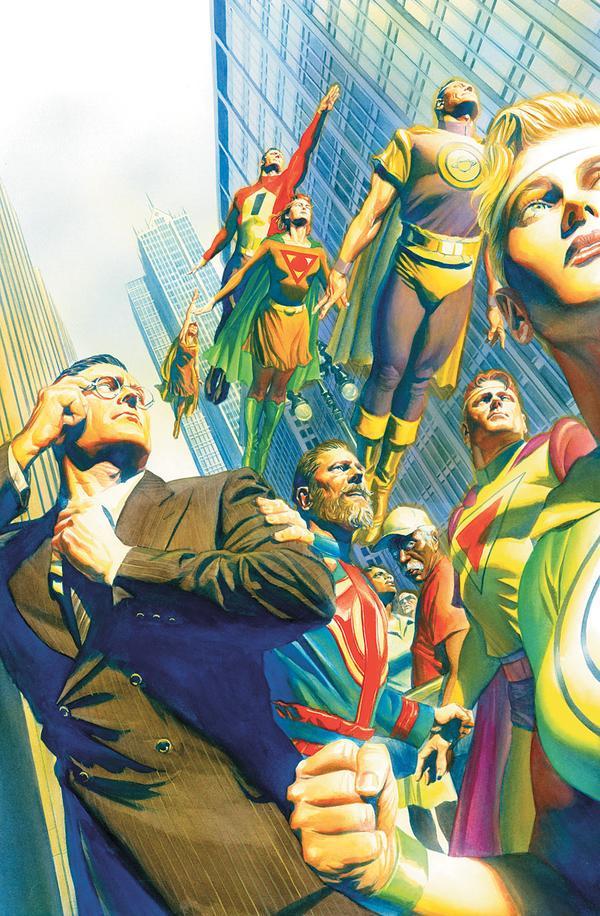
SUPERMAN #682
Writer: James Robinson Artist: Renato Guedes Publisher: DC Comics Reviewer: Optimous Douche
I know the term “zombie” is generally attributed to the blind followers of all things Marvel, but I’m of the mindset that DC fans can be counted amongst the slack-jawed fandom undead. Why? Because I am one, and this latest New Krypton crossover that is bleeding across all things Superman is proof of my DC logo shaped lobotomy scar (the old star one, not the DC/Nike swoosh).I immediately dropped Superman proper after the first issue of Robinson’s “Atlas” run vowing not to return until a new writer took the helm. While I liked some of the concepts, like Superman playing fetch in space with Krypto, the characterization simply felt wrong (I never want to think of Superman with a boner). Even if I could get past my predispositions on the proper voice for the Big Blue Boy Scout, the endless panels with the “science cops” put the final nail in the coffin. Not only is the name void of any imagination, I read Superman to see Superman. If I wanted to watch a bunch of cops tricked out in high-tech gadgetry I would rent “Robocop”.
But as I said earlier, I’m a zombie. When the New Krypton story started with the delectable numbered shields on each cover, accompanied by my single favorite artist Alex Ross, I could not abate my insatiable hunger to follow each chapter. Yes, I traversed Supergirl for the first time and plunked down my shillings for the one-shot. It felt like the early 90s all over again, where as a hapless teenager I relied on those shield numbers to waft away the short term memory loss from my endless bong cloud and keep my proverbial continuity shit straight. This is the first time in a long while where there has not been a slew of disconnects or needless filling in a crossover. I’ve enjoyed every damn minute of Kandor’s giant size resurrection and their encroaching quest to take over our world. That is until this issue.
It’s not that this issue was bad, but like the last installment, the best word I can use to describe Robinson’s approach is sterile. Where Johns will bring rich characterization while moving the story forward, Robinson seems to simply transcribe events. Last issue we saw the resurrection of Doomsday, but not once did I yelp “holy shit, its Doomsday,” because I think I was simply numb by the time he arrived. Not disgusted, but numb.
This was a big issue, or should have been. For the first time the citizens of Kandor decide to bring Kryptonian justice to earth by locking away some of Superman’s lead foils in the Phantom Zone. Sadly, the abductions are hastily shoved into one page each. Prankster, Parasite and the rest barely get air time (Parasite simply stays locked in a box, never once oozing some of his sarcastic wit). Instead we are treated to several pages of The Guardian being turned down for a job, more time with my most hated law enforcement officials the science cops (seriously, please give them a new name like Beakers with Badges, Mr. Wizard’s Top Bitches, I’ll take anything at this point) and a lesson on morality when Kandor’s finest cream a few cops of science during the abductions. I’m not so staunch that I will say every minute of a Superman book must contain Superman for me to care, but the way this title was delivered I just didn’t have the face time or the desire to care about anyone. The only moment that felt truly real was when Superman confronts his Aunt and Uncle about the abductions and Aunt El ends up becoming a Nazi justice bitch on wheels. She was the only character that I felt transcended simply being a plot device to get us to the next chapter.
The rest of my disdain stems from Guedes’ art. Again, not bad, but it just leaves me cold and totally void of any feeling. Plus, I have one fanboy continuity nit. When the denizens of Kandor bust into Arkham there is a scene with Nightwing and Robin lying on the ground unconscious. I understand that their mortal abilities transcend the norm, but come on. There was nothing to stop Kandor’s forces from snapping the Bat Boys’ spindly little necks with one shot of super breath. This is a scene that just should not have been drawn.
When New Krypton is finally packaged in TPB format, these issues will simply serve as a brief respite between all the great storytelling goodness happening in the other titles. However, as I wait each week for new chapters to unfold, I don’t want a respite, I want to feeeellllll (and I’m not emo so I can’t cut myself)!
When Optimous Douche isn’t reading comics and misspelling the names of 80’s icons, he “transforms” into a corporate communications guru. Optimous is looking for artistry help, critical feedback and a little industry insight to get his original book AVERAGE JOE up, up and on the shelves. What if the entire world had super powers? Find out in the blog section of Optimous’ MySpace page to see some preview pages and leave comments.
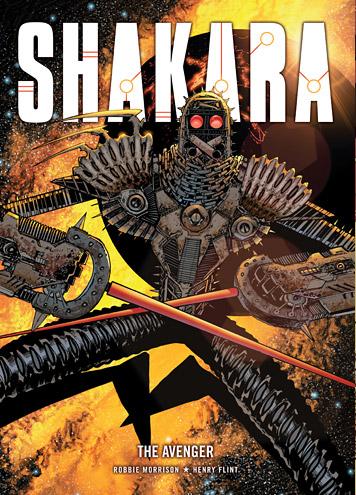
SHAKARA: THE AVENGER TPB
Writer: Robbie Morrison Art: Henry Flint Publisher: 2000AD Reviewer whose hips don’t lie: Ambush Bug
No, it’s not the story of the saucy Hispanic singer who shakes her ass like a Home Depot paint mixer. But I challenge anyone who reads this book not to walk around screaming SHAKARA to anyone who crosses your path. There’s something therapeutic saying that word in the face of opposition. Try it. You’ll see how fun it is. Next time your boss yells at you for spending too much time on that moobie site run by the fat guy, just shout SHAKARA in his face. It may not be a good career move, but I guarantee it’ll feel really good.Although SHAKARA is at its core a revenge flick in comic book form, writer Robbie Morrison (co-creator of another 2000AD fave NIKOLAI DANTE and writer of many a JUDGE DREDD story) and artist Henry Flint do a fine job of setting up interesting and original fodder for Shakara to slice through. Somewhat formulaic, though interesting enough to sustain my interest from cover to cover, the trade paperback compiles three SHAKARA stories originally printed in 2000AD Magazine.
A huge part of what makes SHAKARA so great is Henry Flint’s electric artwork that never shies on fine details or vivid angles. Flint’s creature design is equally jaw-droppingly good as he makes sure to draw every alien unique, distinct, and anatomically functional.
The story focuses on the sole survivor of a race of formidable fighting machines who were so good at dealing death that they prevented chaos and terror from spreading through the galaxy. The Shakara were an honorable and moralistic race of few words and formidable action, so of course the race made some enemies. Story one sticks pretty close to revenge flick form, as the sole surviving Shakara makes mincemeat of bounty hunters, mad scientists, and evil telepaths. In story two, the baddies get smart and hire the deadliest assassin in the galaxy to take the mechanical menace out. But it’s the third story in this trade that really shines story-wise, as Morrison goes into the history of Shakara race and the motivations of the sole survivor. Morrison plays with the reader’s sense of right and wrong by making the Shakara ambiguous. Did they deserve to be wiped out? Did the cadre of bad guys do the galaxy a favor by taking out such a bloodthirsty and dangerous race? Is Shakara just as evil as the monsters he’s tracking down? There are no easy answers, just a bad ass robot-looking murder machine that says the word “Shakara” a lot. And that’s cool enough for me.
SHAKARA!
Ambush Bug is Mark L. Miller, reviewer and co-editor of AICN Comics for over seven years. Check out a five page preview of his short story published in MUSCLES & FIGHTS 3 (AVAILABLE NOW at Muscles & Fights.com.) on his ComicSpace page. There you can also see a five page preview of his short story in MUSCLES & FRIGHTS! Bug was recently interviewed here and here at Cream City Comics.
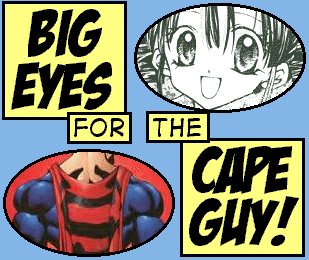
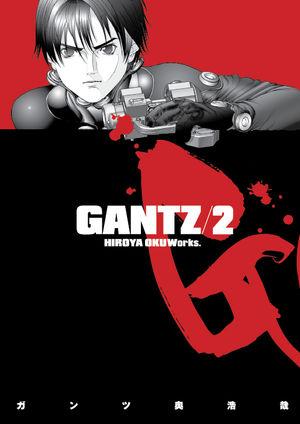
GANTZ Vol. 2
By Hiroya Oku Released by Dark Horse Manga Reviewer: Scott Green
While the character of the field qualifies this statement to some degree, I still feel comfortable saying that GANTZ is the nastiest manga in the North American market. (Yeah, I know how it compares to something like Shintaro Kago's work, but it's not like we're seeing much of that). Even if we did get more seinen manga, classic GO NAGAI works and so on; even if older males were still the prime audience for manga in North America, I still think GANTZ's pools of blood and bodies, cracked jaws, and severed limbs would stand out.With frequent ventures into the alluring, seen in GANTZ's pin-up, fashion shot chapter-title card illustrations, his body of work and his SOUL CALIBUR IV design, no one is going to mistake Hiroya Oku for a manga Michael Haneke, but at the same time, he has a way of making GANTZ's world of defying death and hanging with busty girls fascinatingly unpleasant. In volume two of this cool, sexy wish fulfillment gone hideously ugly, the manga isn't driven by a concern as to whether the characters will live or die. Instead, it is intriguing to watch a manga get straight to the action, turn violent and do so without any accompanying sense of vindication. The spectacle of seeing extraordinarily bad things happen to unpleasant or mundanely bad people feeds into the uneasiness, piling up a morally and viscerally terrifying manga.
In Volume One, disaffected teen Kei Kurono ran into long separated childhood friend Kato just long enough for Kurono's noble minded peer to guilt him into leaping onto a subway track to help save a fallen homeless man. The good deed did not go unpunished, with a bit of body shattering rekishi - death by being run over, courtesy of an oncoming express. The pair was revived in an apartment that was barren except for a black sphere and populated by a pair of yakuza toughs, an unimpressive looking elementary school teacher, a dog, an old politician, a young male actor/model/whatever, an evil looking junior high aged kid and a naked young woman.
The surface of the sphere displayed a mug shot of an "onion alien" with the message "will all of you please go and finish off this guy," before opening up to offer racks of labeled suitcases and an arsenal of sci-fi guns. The confused crowd had a few minutes to gear up with weapons and black skintight outfits (in most cases, the latter option is forgone), before they were transported into a regular looking neighborhood.
After finding the childlike "onion alien," things took a turn for the gruesome. Most of the group seemed to think they stumbled into a well staged prank TV show, while Kato wept at his inability to stop the wrongs going on in front of him and the teacher openly questioned whether the group was being subjected to some sort of Eichmann Test.
As Volume Two opens, the blow back from the impromptu humanoid bug hunt has begun. A group of people who, for one reason or another, should have been dead were given video game weapons and put into a situation with a rightfully livid ogre. Objectively, it probably should not be surprising to find that the results encompass plenty of sundering, reaming and concaving, or that, as they say, the rain falls on the just and unjust alike.
As a fan of seeing what a clever manga creator with an eye towards grisly spectacle can do with the medium, I'm admittedly predisposed to liking GANTZ. I'm not necessarily an enthusiast of the live action gore flicks, but there's something about the twin challenges of conveying something convincing in an abstract form and contending with the possibility of the empty page that excites me about the artistry of violent manga.
GANTZ is serialized in prominent seinen anthology WEEKLY YOUNG JUMP, which is the new home to ROZEN MAIDEN (allegedly Prime Minister Taro Aso's favorite manga), and Takehiko Inoue's wheel chair basketball manga REAL. And it works from the foundations of what a seinen title needs to do to grab the attention of an audience that is comparable to the demographics of Spike TV.
Seinen series like GANTZ and BLADE OF THE IMMORTAL, as well as particularly violent, younger audience shonen (FIST OF THE NORTH STAR) have an interesting place in the North American manga scene. Many of the forerunners in the commercially released manga field came from these genres (in other words, the releases that hoped to attract buyers rather than introduce audiences to something significant, like the translations of BAREFOOT GEN or PHOENIX). However, the manga boom crowded these series into a niche. In summer 2008's top manga sales estimates, I'd only put 24 BERSERK and 50 GANTZ in this category.
As a manga that will startle any reader to attention, I can see why Entertainment Weekly gave GANTZ a positive nod. It's splattery teensploitation that holds up when compared to like in any medium. By the same token, I can see why GANTZ has not been a critical darling among manga commentators, as it's been slapped with some notable mild to negative marks.
On one hand, I have no hard evidence for the assertion that I'm about to make. On the other, given what's popular in other media (see the success of a SAW movie or a game like DEAD SPACE), there has to be a reason why seinen trails the manga charts. It's as if there's a separation between the interest and the product. Manga enthusiasts largely aren't seinen fans and the equivalent of seinen fans largely aren't manga buyers.
Here's what the manga fans who don't care for seinen and the seinen fans who don't buy manga are missing out on.
In setting an unimpressive selection of humanity loose with ray guns, then observing the pendulum swing of brutality, as the goons hurt others and in turn are themselves hurt, the manga starts looking like a metastasized case teenage angst and urges.
Oku knows that he's writing for an audience who is interested in seeing naked flesh and shattered bodies. Volume 2, doesn't have anything like volume one's "Naked Suicide Girl," in which a young woman is plucked from a bathtub wrist cutting, cleaned up, and laid out in her fleshy, naked state for 20-something pages. It does however take long looks at channels of digitally inked blood running over 3D models and it frequently tracks back to the scene of the crime for another look at the piled carnage. One of the inherit strengths of manga is its ability to close in on one image and allow the viewer to stare at this instant without derailing the moving narrative. GANTZ's large panels suggest rapid reading, but then it takes unflinching gapes at snap-sudden grievous consequences.
This crystallized view of what's happening, cemented by mundane backgrounds and attention to realism in the rendering of people and places, is at odds with the subjective experience. The characters can't mentally reconcile how much trouble they're in. They keep drifting into the notion that they're part of a TV show, or they're screaming in frustration, trying to coax a gentler resolution to their predicament. The manga works to suggest a video game metaphor for what's going on, and consequently, applying a harmless framework for a severe conflict becomes easy. Meanwhile, we see characters graphically die in unenviable, non-heroic fashion. They might not have been the world's most noble people, but seeing it happen provokes some of the same feelings of frustration and rage that they express.
Personally, I loathe a story that both criticizes and indulges in excess. It would be one thing if GANTZ tut-tut-ed the attitudes to which it appeals. Similarly, I'm inclined to think that GANTZ would not work as a straight satire. What it does do, which I'm a fan of, is allow itself to get wound up and self-aggravated. Near the end of Volume Two, the black sphere sizes up the recent combatants with the kind of juvenile note book scrawl that a middle schooler would dedicate to a disliked classmate. This ability of the manga to jeer at itself might be the right attitude for a story that both plays to and rolls its eyes at prurient interests.
The first pages of the manga features Kurono standing on a subway platform, thumbing through the bikini photos in a Jump magazine (the one that prints GANTZ) while glancing from the mag to critically size up the people around him. "I may look stupid...but to tell the truth, I know I'm better than everyone else in the world." This sullen, egotistical teen contrasts the Kurono that Kato remembers from their childhood, who was brave, clever and noble, capable of thwarting bullies and scraping through unthinkable stunts. Given a super suit, and the instincts to be the only one in the group to put the thing on in the apartment staging area, Kurono is given a unique opportunity to impress the girl and demonstrate that he actually is better than ugly, unthinking world around him.
Assessing GANTZ via the criteria that Kurono sets for himself in that opening monolog can be provocative. He isn't exactly proven wrong. After a fashion, he does look brighter than the masses. Beyond that, his wishes are fulfilled. Then again, so much ends in disaster or near disaster, and so much is agony that the character has tears streaming down his face, and the vicarious reaction is teeth gritting frustration or a pained grimace.
There's a discussion among commentators as to whether watching horror is an act of sadism or masochism. The pleasure of GANTZ would suggest the latter. It's a compelling manga driven by its horrific violence, but it's working towards more than just something to gape at. Despite the fact that it's offering the spectacle of not-so-good people taking their lumps, it's more queasiness inducing than exhilarating.
By no means is GANTZ an entirely airtight, cerebral work. These first two volumes make up an introductory phase of the manga. As such, I can't really say if they're developing a well considered statement or laying out disconnected, but provocative ideas. I can say that I'm not wow'ed by how it’s establishing its plot mysteries. A particularly irksome bit is dropped in at the end of the volume to explain some of the core sci-fi conceits. An admitted liar gives the survivors of the "Onion Alien" a few answers to their questions, mostly in the form of theories. Other than the "I'm an alien" outright BS, the manga hasn't really offered enough evidence to filter the information from the misinformation. Beyond that, if the "theory" is in fact a theory, having a character intuit vital information seems like a cheat.
I don't want to oversell GANTZ, but its first two volumes do showcase the kind of incendiary, violent material that makes seinen an exciting segment of manga. Between this, BLADE OF THE IMMORTAL, MPD PSYCHO, KUROSAGI CORPSE DELIVERY SERVICE and so on, Dark Horse is putting out a number of releases that should keenly interest Ain't It Cool News Readers.
Scott Green has been writing for AICN ANIME for close to seven years. If you like what you see here and love anime & manga, be sure to check out his latest AICN ANIME column here.

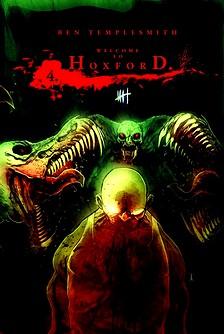
WELCOME TO HOXFORD #4 IDW Publishing
Ben Templesmith's werewolf prison tale comes to an end with this issue. The story turned out to a very gory and brutal one. There aren't too many GOOD werewolf books out there, so it's nice that this book even exists. This is the "all hell breaks loose" issue and it certainly does in spades. One minor complaint is that because of Templesmith's loose style, it's difficult to distinguish one character from the next in this issue. That may be because of all of the fur and body parts flying around, but there were a few panels where I wasn't sure who I was seeing. Then again, Templesmith's style gives off a welcome creepy feeling while reading it and the unidentifiable panels only adds to the chill-factor. WELCOME TO HOXFORD has a much heavier tone than Templesmith's WORMWOOD: GEMTLEMAN CORPSE and shows that the artist/writer has got some range. I'm looking forward to reading more of Templesmith's tales of terror to see what else he's got in his artist's bag of ghoulish fun. - Bug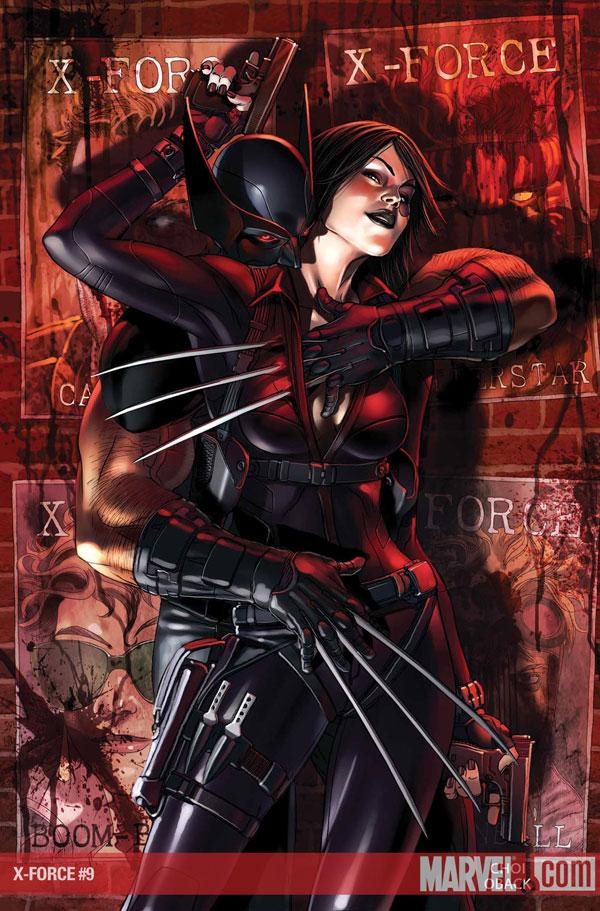
X-FORCE #9 Marvel Comics
I hadn’t picked this book up in a few months, because the last time I did, it kinda sucked. Maybe it was some of the over-stylized art. Maybe it was the horribly shopworn themes of religious zealots and “satanspawn-blabity-blah-blah.” But this issue…geez, when did X-FORCE stop sucking? Because this issue was excellent and interesting. Maybe it was the introduction of Domino as the newbie POV (point-of-view) character (since she’s normally a world-weary person, the counterpoint here was VERY well-played.) Or maybe it was the always dependable Mike Choi on pencils. Maybe the storyline was just better overall. Lotta maybes. All I can tell you for certain is that the potential I saw in the first issue lineup seems to be much more solidly realized here. Given the high talent of the writers, I’m happy to see the book rising to their level, and I hope it stays here. - Rock-Me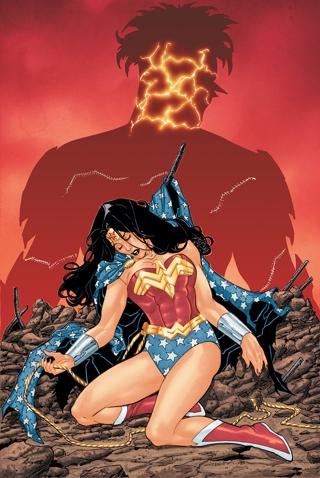
WONDER WOMAN #26 DC Comics
I'm trying really, really hard to like Gail Simone's WONDER WOMAN series. So far, she's thrown everything but the kitchen sink at Diana and my interest has yet to be piqued. A trip to Hollywood to a Wonder Woman movie set. A team-up with the Slayer and Beowulf. And in this issue, Wonder Woman faces an unstoppable force with god-like powers named Genocide. Maybe it's because Genocide looks a lot like Doomsday. Or maybe it's because she acts a lot like Doomsday. Or maybe I'm just distracted by the spikes that block the new character's eyes, which explains why Genocide doesn’t see how much like Doomsday she really is. Or maybe because this new villain beat the snot out of Wondy, just like Doomsday did to Superman. For years, writers have tried to make Wonder Woman interesting. I've read tons upon tons of WONDER WOMAN comics. I WANT to like reading a WONDER WOMAN comic, but for the life of me, no matter what new slant a writer has for the character or new challenge one cooks up for her to face, I can't muster up more than a meh. This issue is more of the same; mainly because this "scary" new villain is just Doomsday with boobs. Boobsday? Hmmm… - Bug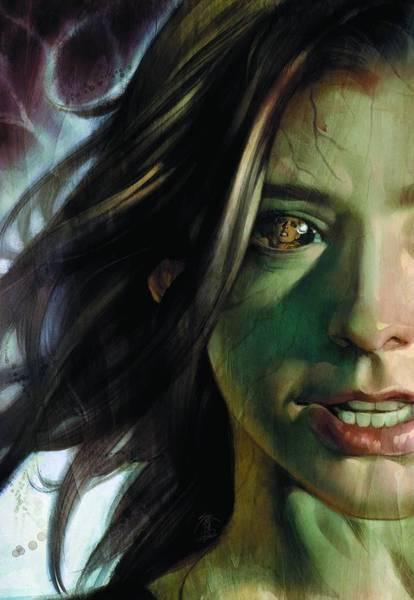
BUFFY SEASON EIGHT #19 Dark Horse Comics
So ends an arc that was greatly anticipated by many fans. I wasn’t one of them, oddly. I didn’t pick up Fray until it had been collected, and thus, I missed out on the many months of slavering for a final issue that seemed destined never to appear. The fact that Buffy Summers and Melaka Fray teamed up was, to me, just another Buffy story. All that said, I thought it was top notch, and didn’t realize how much I liked the Fray character until now. I also didn’t realize I’ve missed Karl Moline’s pencils, which was the main reason I picked up the LONERS series many months ago (well, that and seeing a grown up Julie Power.) Bottom line on this: if you like Buffy, you would have loved this arc and at least liked this issue. If you’re a fan of good stories and good storytelling, then you would probably like this arc and this series. And if you hate Whedon, then this issue won’t change your mind, because dude, it’s classic Whedon, however that strikes you. - Rock-Me
